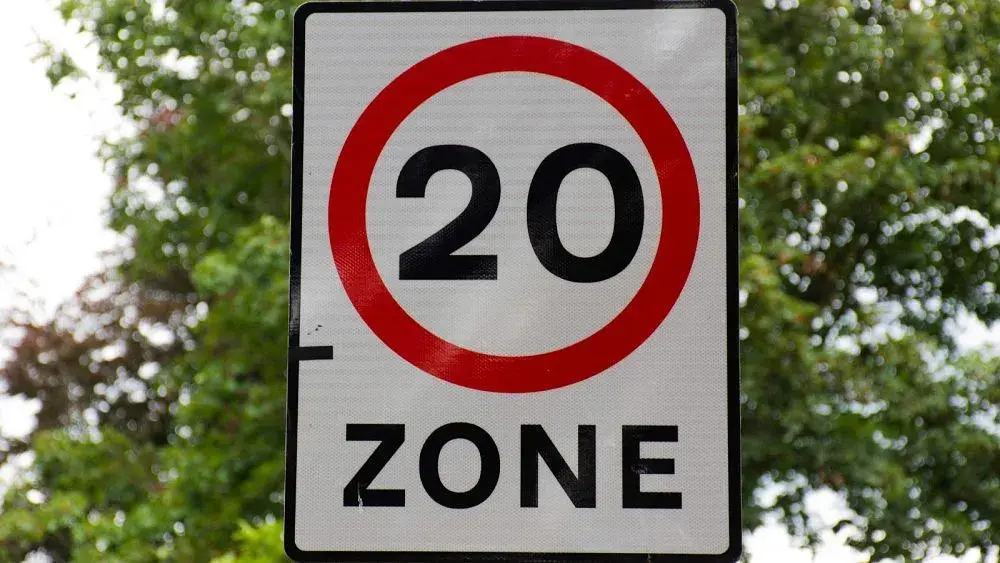- cross-posted to:
- fuck_cars@lemmy.ml
- cross-posted to:
- fuck_cars@lemmy.ml
For more detailed information: https://www.gov.wales/introducing-20mph-speed-limits-frequently-asked-questions
They just want to make money. They’ve covered the country with cameras and then they dropped the speed limit to a brisk walk. Breaking 20mph is almost guaranteed by accident, and those cameras are going to snitch.
Good job guys.
20mph is significantly safer than 30mph, that’s all there is to it
If you follow that logic to its conclusion - 0 is the safest speed limit.
(Not trying to argue about the topic, just pointing out the obvious - all speed limits are a tradeoff)
This doesn’t really apply because harm to a pedestrian during an impact isn’t a linear scale.
There are sharp decreases in fatalities and permanent injuries, particularly to children who are often the ones hit in neighbourhood streets, below about 30 km/h so there’s a strong incentive to have drivers travelling at speeds no higher than that to avoid child murder and maiming due to inattention.
Below those speeds, and given that people do often belatedly apply the brakes when they’re driving recklessly there is a much weaker case for further reduction in speed limits. At least until car geometry changes again to make them even deadlier /shrug shrug
Now, you see - that’s a completely different argument.
And also validates my point, all speed limits are tradeoffs.
Don’t get me wrong though, 20mph/30kph limits are commonplace where I live and honestly surprised to hear that it wasn’t everywhere.
For improved safety in the future we’ll need better driving assistance systems in the cars, and finally to replace humans altogether.
I agree, it’s a trade off. That’s why reducing car usage is the most important thing. Making it less convenient to use a car, and more pleasant to walk and cycle are some of the ways you can do that.
Carrot or stick?
Both are needed
If people can’t follow the speed limit they should be fined.
What’s the point in speed limits if they aren’t enforced?
I’ve never had a problem driving 20. In fact I do it voluntarily in some build up neighbourhoods.
Plus 20 mph is basically sprinting.
Edit:
Yes, 15mph is very fast for a runner as it equates to a 4-minute mile. 15mph represents the fastest a human can run, with extensive training,
Speed limit changes should be accompanied by speed humps / raised crosswalks, narrower lanes, narrower vertical space using trees, planters, bollards, etc, more frequent stops or mini roundabouts, curb bumpouts, etc etc.
Just changing the speed limit without changing the physical space will only do so much.
They’re not just lowering the speed limit. From the FAQ:
Will the roll out involve money being spent on speed bumps?
There is no plan to include traffic calming (including speed bumps) as part of the change to speed limits. There are other ‘softer’ measures that might be introduced, such as using buffer speed limits, removing the centre line, narrowing the carriageway visually, using planting etc.
Good. We not only have to make PT and cycling more attractive, we have to make driving less attractive.
Great news, people don’t realise how much safer 20mph is than 30mph.
While it sounds good on paper, in practice, they’ve screwed it up. They’re putting the new speed limits in place on every 30mph road in Wales before they’ve put the public transport alternatives in place.
There’s currently no reason for someone to switch to public transport, especially if the buses are going to be stuck at the same speed as the cars, but stopping regularly too. Our roads are too narrow to install bus lanes, and barely have enough room for single file traffic through lots of the towns and villages. The trains are being upgraded, but that’s not scheduled to finish until at least next year, and at the moment they’re slow and very unreliable. It feels like every week the trains are cancelled and an inadequate replacement bus service is put on.
I’m disabled, and have to travel from my town, Aberdare, to the main hospital in Cardiff, UHW, on a regular basis. If I had to leave now, it would take 42 minutes by car, or 2 hours and 6 minutes by public transport. The shortest journey is tomorrow morning and would take 1 hour and 31 minutes, more than double the time of the car journey. The closest inpatient hospital is 22 minutes by car, or over an hour by public transport. The difference the new speed limits are going to make is negligible compared to how slow public transport is here.
All this is going to do is annoy and upset people, and turn them off the idea of using public transport, and push a lot of people towards voting for the parties who were against this. Out of the main parties, that mainly seems to be the Conservatives, so that’s going to be bad for all of us.
I’m not from Wales, so I don’t know how good the cycling infrastructure is there. But for me this change would make me feel much safer cycling on busy city streets. So this might encourage a few people to take their bike instead of their car.
The person you replied to is disabled - or so he claims, even if we assume he is lying about that, there are other people in his town who actually are disabled (I don’t even have to look, disability is common enough around the world). While bikes are great for “normal people”, they are not an answer for the disabled who may not be able to ride them at all. As such while cities should encourage more biking, they should not make bikes the backbone of how people are expected to get around.
or so he claims, even if we assume he is lying about that
…what reason would we have to assume this, and why even bring it up if there isn’t reason to?
Because on the internet people lye about things all the time.
I’m aware that the person is disabled, but they explicitly stated in their comment that “there’s currently no reason for someone to switch to public transport” and that “all this is going to do is annoy and upset people”. That to me implied that they didn’t think of cycling as an alternative to driving a car at all, which is understandable given that they probably can’t cycle. So all I did was offer the perspective of someone that does cycle and has to ride on busy streets because there are no bike lanes in hope that they’d appreciate that perspective just as much as I’d appreciate someone giving me their perspective when I’m missing something due to my personal circumstances.
I agree that there need to be alternatives to cycling in place for those that can’t or don’t want to cycle. Its all about capacity planning, though. If you assume that 20% of your population will use bikes for short to medium distances you’ll have to plan with much more frequent and larger busses or even consider building subway or train infrastructure to get all these people to their destination than if you assume that 70%-80% will use their bikes. So as a transportation planner you’ll need to make a judgement call on how you want the future of transportation to look like in the area you’re responsible for, but I don’t think the choice to make biking the backbone of transportation is necessarily to the detriment of everyone else. To the contrary, the public transport might be less crowded if most people use their bikes, so that for example folks in wheelchairs or those with trouble walking have it easier to get on and off.
This is becoming more and more the default speed limit in German cities (30 kmh actually, which is more or less the same).
30 mph = 48 kph. That’s not really the same at all.
30 mph isn’t an unreasonable default speed, but 30 kph is really slow unless you’re talking a dense city core.
20 mph are 32 kph. This is pretty much the same, isn’t it? I think you might have misread my comment somehow.
Sounds dumb
Why do you think that’s stupid?
Whales don’t even drive.
I’ll bite. Arbitrarily lowering speed limits while still leaving the road the same means many people will drive the old speed (as that is what will “feel” right). Great if you’re trying to rack up photo radar ticket income, not so great if your motives are better safety and fewer cars on the road.
They’re not just lowering the speed limit. From the FAQ:
Will the roll out involve money being spent on speed bumps?
There is no plan to include traffic calming (including speed bumps) as part of the change to speed limits. There are other ‘softer’ measures that might be introduced, such as using buffer speed limits, removing the centre line, narrowing the carriageway visually, using planting etc.
might be introduced
So no, currently they’re not doing anything else.
Technically, they aren’t doing anything. This is “just” an announcement if you’re going to be pedantic.
Waterloo, Ontario, Canada is going through a similar process of lowering speed limits in residential areas. The planning staff said they needed the speed lowered so they could implement these traffic calming measures, otherwise the speed limit would be higher than the street design can accommodate. Obviously, the devil is in the details, but it’s a good and important first step.
I think this policy will fail to be honest; while I’m not in Wales any more Oxford where I live now is a supposed ‘cycling city’ with most roads at 20 mph and honestly I hate being on the road there either in a car or on a bike; I get the bus in even though it’s often flaky. Driving you’re sat between second and third gear the whole time so you’re either revving too hard and wasting petrol or the car naturally speeds up so you’re spending a lot of attention on not getting fined rather than keeping it on the road, and when you’re cycling the cars that do keep to 20 mph linger beside you for what feels subjectively a lot longer when they overtake which isn’t fun either and the tiny bike lines make you feel vulnerable to traffic. I had a lot of near misses when I did it regularly and Oxford is a very small city, the idea of cycling somewhere like Cardiff would be terrifying to me.
Funny how the cars in the UK are geared differently than the ones in the rest of Europe, who seem to have no problem driving at ~20mph
Good for them, doesn’t change the fact I find driving at 20 mph very frustrating compared to 30 mph for that reason.
Ok then drive slower it’s a speed limit not a speed target











